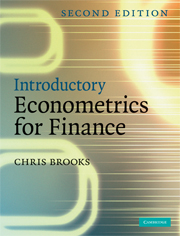Book contents
- Frontmatter
- Contents
- List of figures
- List of tables
- List of boxes
- List of screenshots
- Preface to the second edition
- Acknowledgements
- 1 Introduction
- 2 A brief overview of the classical linear regression model
- 3 Further development and analysis of the classical linear regression model
- 4 Classical linear regression model assumptions and diagnostic tests
- 5 Univariate time series modelling and forecasting
- 6 Multivariate models
- 7 Modelling long-run relationships in finance
- 8 Modelling volatility and correlation
- 9 Switching models
- 10 Panel data
- 11 Limited dependent variable models
- 12 Simulation methods
- 13 Conducting empirical research or doing a project or dissertation in finance
- 14 Recent and future developments in the modelling of financial time series
- Appendix 1 A review of some fundamental mathematical and statistical concepts
- Appendix 2 Tables of statistical distributions
- Appendix 3 Sources of data used in this book
- References
- Index
4 - Classical linear regression model assumptions and diagnostic tests
- Frontmatter
- Contents
- List of figures
- List of tables
- List of boxes
- List of screenshots
- Preface to the second edition
- Acknowledgements
- 1 Introduction
- 2 A brief overview of the classical linear regression model
- 3 Further development and analysis of the classical linear regression model
- 4 Classical linear regression model assumptions and diagnostic tests
- 5 Univariate time series modelling and forecasting
- 6 Multivariate models
- 7 Modelling long-run relationships in finance
- 8 Modelling volatility and correlation
- 9 Switching models
- 10 Panel data
- 11 Limited dependent variable models
- 12 Simulation methods
- 13 Conducting empirical research or doing a project or dissertation in finance
- 14 Recent and future developments in the modelling of financial time series
- Appendix 1 A review of some fundamental mathematical and statistical concepts
- Appendix 2 Tables of statistical distributions
- Appendix 3 Sources of data used in this book
- References
- Index
Summary
Learning Outcomes
In this chapter, you will learn how to
Describe the steps involved in testing regression residuals for heteroscedasticity and autocorrelation
Explain the impact of heteroscedasticity or autocorrelation on the optimality of OLS parameter and standard error estimation
Distinguish between the Durbin–Watson and Breusch–Godfrey tests for autocorrelation
Highlight the advantages and disadvantages of dynamic models
Test for whether the functional form of the model employed is appropriate
Determine whether the residual distribution from a regression differs significantly from normality
Investigate whether the model parameters are stable
Appraise different philosophies of how to build an econometric model
Conduct diagnostic tests in EViews
Introduction
Recall that five assumptions were made relating to the classical linear regression model (CLRM). These were required to show that the estimation technique, ordinary least squares (OLS), had a number of desirable properties, and also so that hypothesis tests regarding the coefficient estimates could validly be conducted. Specifically, it was assumed that:
E(ut) = 0
var(ut) = σ2 < ∞
cov(ui, uj) = 0
cov(ut, xt) = 0
ut ∼ N(0, σ2)
These assumptions will now be studied further, in particular looking at the following:
How can violations of the assumptions be detected?
What are the most likely causes of the violations in practice?
[…]
Information
- Type
- Chapter
- Information
- Introductory Econometrics for Finance , pp. 129 - 205Publisher: Cambridge University PressPrint publication year: 2008
